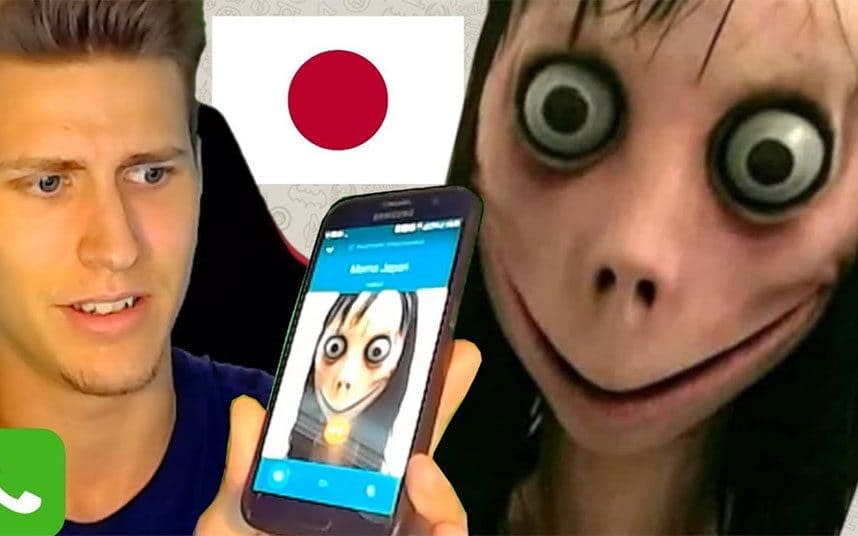Is the Momo challenge a hoax or risk? Four things parents and schools should know about the game

Over the past couple of days, the internet has been awash with stories about Momo: from parents worried about whether it will affect their children to police issuing statements warning people about the "challenge".
But, recent coverage has left many parents confused. So, what really is Momo, and should we be worried?
Where did Momo come from?
Concerns in recent days have focused around the "challenge", which reportedly prompts children to contact a fictional character, Momo, and to be set a series of dangerous tasks.
The Momo character comes from a sculpture, created by artist Keisuke Aisawa at the Link Factory, which specialises in horror film props. Photos of the sculpture were posted online and shared thousands of times on Reddit.
It was only last year that local media in South America began linking the image with the challenge, which they say was responsible for multiple deaths among children, although those reports could not be verified.
It entered the English-speaking world last year, with high profile names such as ReignBot, a YouTuber with more than half a million subscribers, discussing the challenge, and there have since been various bodies warning about the risk it could pose to children.
The latest wave of concern appears to stem from a post from a mother in Lancashire, in which she claimed other children had told her son to look up the "Momo challenge" online, as well as comments from police that they are working to stamp out the "extremely disturbing challenge" in the UK.
Police in Northern Ireland, for example, described it as a "suicide game targeting our kids".

Is Momo dangerous?
There are no confirmed cases of British children having harmed themselves because of the challenge, prompting some to brand it a "hoax".
But, whilst there is no evidence of physical harm to children, there is evidence it is highly distressing to those coming across the image whilst watching unrelated videos.
The Daily Telegraph earlier this month found multiple videos featuring the Momo challenge on YouTube and Instagram, including videos made by YouTubers completing a challenge, and in children's cartoon Peppa Pig.
One mother claimed her children had seen the image on YouTube Kids, and that it had left them "sick and terrified".
She wrote in a post on Facebook that her daughter "immediately went into a state of holding her ears and telling me not to say anything... I only mentioned [Momo's] name".
Both YouTube and Instagram removed the flagged videos once they had been alerted to their existence, saying content promoting self-harm was prohibited on their platforms.
YouTube said at the time that its guidelines "prohibit content that's intended to encourage dangerous activities that have an inherent risk of physical harm or death", while Instagram said that "nothing is more important to us than the safety of the people who use Instagram".
"Content or accounts that encourage others to harm themselves are not allowed and we will remove them as soon as we are made aware," it added.
What can we do to protect children?
Children's charity Kidscape has called for social media platforms to be doing more to stop disturbing content appearing on their platform, saying at the moment they are "not doing enough".
This is not the first time social media platforms have faced pressure to clamp down on the type of content that appears on their sites.
In fact, multiple reports in the past have detailed how distressing content is still being found on the sites. Earlier this month, major companies AT&T, Nestle and Fortnite's Epic Games pulled their advertising from YouTube after it emerged that they were appearing next to videos predators were using to exploit children – something YouTube said it took "immediate action" on.
Kidscape said the latest discussion about Momo, however, presented an opportunity for parents to engage more with their children about their activity online, urging them to "support children to say no to people telling them to do something they don't want to do, online and offline, and be curious about their online lives".
Earlier this year, police in Northern Ireland released their own warning to parents saying it was "crucial that parents are involved with their online lives".
"I’d urge parents to make children aware of online dangers and ensure they know that they can speak to someone if anything or anyone online causes them concern," the police said.
Are schools saying anything?
A number of schools across the UK have issued warnings about Momo over the past few weeks, to provide advice for concerned parents.
Among those was Haslingden Primary School in Rossendale, near Blackburn, which wrote on its Facebook page that it was "increasingly aware of highly inappropriate videos circulating online and are being viewed by children across the school".
"These video clips are appearing on many social media sites and YouTube (including Kids YouTube)," it said.
National Online Safety, meanwhile, said hundreds of parents and schools had contacted it, and millions had read their warning about the game, titled "What parents need to know about Momo".
If adults are concerned or have any questions on how to approach the subject with their children you can contact the NSPCC Helpline on 0808 800 5000 or visit the NSPCC website.
Children who are feeling worried about their activity on apps or online games can contact Childline 24 hours a day, online and over the phone, on 0800 11 11 or by visiting www.childline.org.uk.

